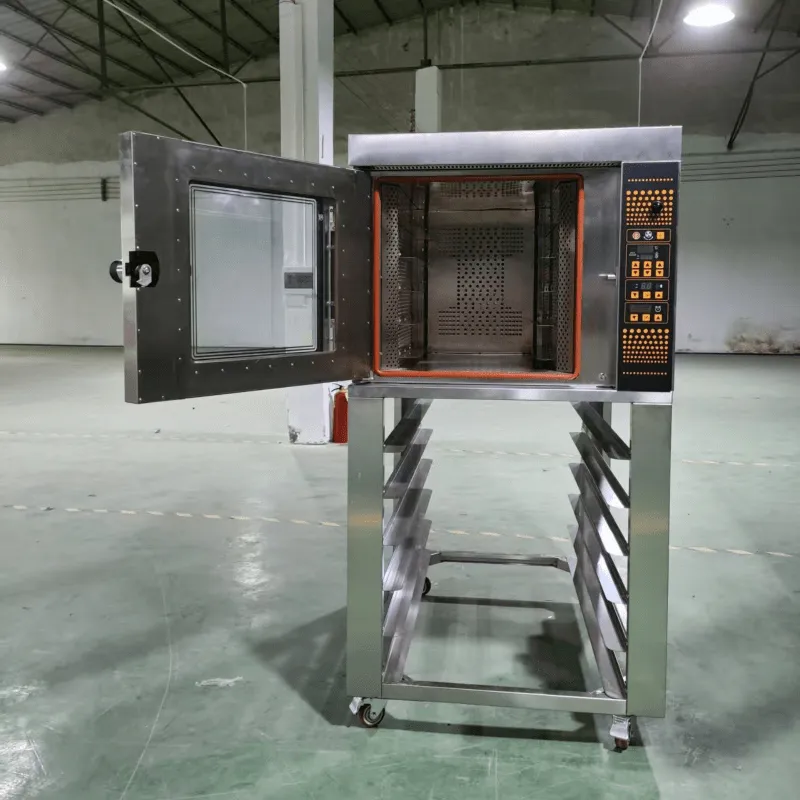Convection Oven vs Regular Oven: Core Definitions
How a Convection Oven Works: Fan-Driven Heat Circulation
Convection ovens work differently from regular ones because they have a built-in fan that moves the hot air around inside. This constant movement helps spread the heat throughout the oven cavity, which means food cooks more evenly across all surfaces. Many home cooks find that their meals finish cooking about 25% faster when using convection settings compared to standard ovens. For folks who love roasted veggies or batches of chocolate chip cookies, this type of oven delivers consistently good results without those frustrating spots where some parts burn while others stay raw. The crispy crust on breads and pastries comes out just right too, which explains why so many professional chefs swear by convection technology for everyday cooking tasks.
Regular Oven Basics: Traditional Radiant Heat
Standard ovens work differently since they rely on radiant heat from gas or electric elements to warm up the interior space, without any fan circulation involved. What happens is that food often gets cooked unevenly because there are hot spots and cold areas developing inside. When someone knows how regular ovens function, they can adjust their cooking techniques. Rotating pans halfway through baking helps balance out those temperature differences so whatever comes out of the oven looks good and tastes consistent across the whole dish.
Heat Distribution and Cooking Performance
Even Cooking in Convection: Faster, Crispier Results
Convection ovens are great at giving consistent cooking results because they blow hot air all around the food. The fan inside creates this airflow which helps everything cook evenly across the board, making textures better and flavors pop more. Some research has shown that stuff cooked in convection ovens tends to get really crispy on the outside, particularly noticeable when making things like chicken skin or breaded items. These ovens work so efficiently that cooks can actually lower their usual baking temps by about 25 degrees Fahrenheit without sacrificing quality, which means food gets done quicker than normal. Plus, despite cooking faster, the food still manages to hold onto moisture pretty well, striking just the right mix between being crunchy on the outside while staying juicy inside.
Hot/Cold Spots in Regular Ovens: Manual Rotating Required
Standard ovens without fans tend to heat food unevenly, creating those annoying hot spots and cold areas we've all dealt with. Because of this problem, most people end up spinning their baking trays halfway through or moving things around just so everything gets cooked properly. Knowing about this issue matters because nobody wants burnt edges while the center is still raw. Keeping an eye on what's happening inside and being ready to move stuff around makes all the difference when working with regular ovens. Once cooks understand how these temperature variations work, they can plan better, adjust timing, and position items strategically, which ultimately turns the whole cooking experience into something that actually works as expected instead of feeling like a guessing game.
Energy Efficiency Comparison
Lower Temperatures, Faster Times: Convection Savings
Convection ovens tend to be pretty efficient when it comes to energy use. They work well even at lower temps and get food done faster than regular ovens. Some research shows these ovens can cut energy usage by around 20 to maybe 30 percent compared to standard models because they run cooler and cook things quicker. Home cooks notice this in their monthly bills too. Food gets ready sooner without guzzling power, which means dinner doesn't take forever and the wallet stays fuller. For folks worried about their environmental impact, the fact that convection ovens need less heat and time makes them an attractive choice for cutting down on kitchen emissions.
Regular Oven Energy Use: Longer Preheat and Bake Cycles
Regular ovens generally eat up more power than their counterparts mainly because they take so long to preheat and bake things properly. Studies show most traditional models need around 10-15 minutes just to get hot enough, and this waiting period makes up a big chunk of their overall electricity usage. The longer cooking times mean regular ovens end up costing quite a bit more in the long run. Home cooks who want to cut down on kitchen expenses should really pay attention to how much power different oven models actually use. When people compare all these numbers side by side, they start seeing which appliances truly match what they need in daily cooking while still being kinder to their wallet and the environment.
With both options analyzed, it's clear that choosing between a convection and a regular oven involves assessing how energy usage impacts long-term costs and environmental considerations.

Key Differences in Cooking Techniques
Adjusting Recipes for Convection (25°F Rule)
Most people know that when they switch to a convection oven, they need to drop the temperature somewhere around 25 degrees Fahrenheit. The difference really matters when baking stuff like cakes or cookies because getting the temp right makes all the difference between something delicious and something that's just okay. Convection ovens tend to finish things quicker than we expect since hot air circulates better, so keeping an eye on the clock becomes super important to avoid burning whatever we're making. Take this scenario for example: let's say a recipe says to bake something at 375 degrees in a standard oven. Just turn down the dial to about 325 in the convection model instead. Doing this helps food cook through properly without turning into dry, rubbery messes nobody wants to eat.
Regular Oven Adaptations: When to Avoid Fans
Standard ovens don't come with fans to move around hot air like convection models do, and this actually works better for certain types of cooking. When making things like souffles or delicate pastries, having no airflow helps them rise properly without getting dried out by all that moving heat. Home cooks should know when to avoid using convection settings, particularly if they're working with regular ovens that sometimes include an optional fan function. The texture difference matters a lot for items that need to stay soft and moist. Most people find that standard ovens handle plenty of everyday baking just fine once they get used to how they work differently from convection units.
Discover more about optimizing your cooking techniques in regular ovens to ensure your dishes are cooked to perfection.
Best Uses for Each Appliance
Convection Strengths: Roasting, Baking, Air Frying
Convection ovens are pretty amazing when it comes to different cooking methods because they have these strong fans that move heat around so well. They work great for things like roasting meat where we all want something juicy inside but with that nice golden crust on the outside. The way the heat wraps around everything makes sure nothing gets burnt while still getting cooked through properly. For folks who love baking cookies or pastries at home, there's nothing better than seeing those edges turn crispy just right every single time. Plus, these ovens actually do a decent job mimicking what an air fryer does too, giving us all that crispy goodness without needing tons of oil. So if someone likes experimenting with various recipes or simply wants meals ready faster than traditional ovens allow, investing in a good quality convection model might just become their kitchen's best friend.
Regular Oven Advantages: Slow Cooking, Delicate Bakes
Standard home ovens work really well for foods that need slow cooking and gentle heat, giving cooks control over how flavors develop and textures form. They're great when making those dishes that take hours in the oven, because the long cooking time actually helps meat become tender and allows all the flavors to blend together nicely. Things like souffles or light sponge cakes get cooked just right in these ovens too, since the heat isn't so intense it dries them out while still keeping their fluffy texture intact. Casseroles come out much better in regular ovens as well, especially when they contain layers of different ingredients that need time to cook through properly. Freshly made bread also benefits from this kind of oven environment where the temperature stays steady throughout baking, which means the loaf will rise correctly and cook evenly across the board. For anyone who likes to experiment with recipes that require careful attention but also plenty of time in the oven, standard models tend to deliver better results than faster alternatives.
Maintenance and Cleaning Considerations
Grease Buildup in Convection Fans: Care Tips
Convection ovens need some love for their fans since they tend to collect grease over time. Cleaning those fan blades regularly makes sure air moves properly through the oven and keeps food cooking right. Most folks find that giving the fan a good wipe down every couple of months works pretty well, especially if they notice greasy spots building up around the blades. Taking care of this simple task actually helps the oven last longer while also cutting down on potential fire risks from all that accumulated grime. When the fan stays clean, the oven continues delivering that consistent heat distribution and better energy use that made people switch to convection in the first place.
Regular Oven Spills: Cleaning Radiant Heating Elements
Ovens need some attention when dealing with spills if we want to avoid those frustrating stains that stick around forever and keep our kitchen appliance looking decent. Want longer lasting heating elements? Stick with safe cleaning practices for the oven regularly. From what I've seen over time, following what the manual says about cleaning works best, particularly steering clear of scratchy stuff that can ruin surfaces. Taking care of those heating parts means better cooking results overall while reducing chances something gets damaged down the road. An oven that stays in good shape just performs better in the long run.
FAQ Section
What is the main difference between a convection oven and a regular oven?
A convection oven uses a fan to circulate hot air, creating even heat distribution, while a regular oven relies on radiant heat sources, which can result in uneven cooking.
How much faster does a convection oven cook compared to a regular oven?
A convection oven can cook meals up to 25% faster than a regular oven, thanks to its efficient air circulation.
Are convection ovens more energy efficient than regular ovens?
Yes, convection ovens are generally more energy efficient, saving around 20-30% more energy than regular ovens due to shorter cooking times and lower temperatures.
Can you use a convection oven for all types of cooking?
Convection ovens are versatile and ideal for roasting, baking, and air frying. However, for delicate recipes requiring gentle heat, a regular oven might be preferable.
How do you maintain a convection oven?
Regularly clean the fan to prevent grease buildup, which helps maintain airflow and cooking efficiency. This routine extends the appliance's lifespan and ensures even cooking performance.
Table of Contents
- Convection Oven vs Regular Oven: Core Definitions
- Heat Distribution and Cooking Performance
- Energy Efficiency Comparison
- Key Differences in Cooking Techniques
- Best Uses for Each Appliance
- Maintenance and Cleaning Considerations
-
FAQ Section
- What is the main difference between a convection oven and a regular oven?
- How much faster does a convection oven cook compared to a regular oven?
- Are convection ovens more energy efficient than regular ovens?
- Can you use a convection oven for all types of cooking?
- How do you maintain a convection oven?

